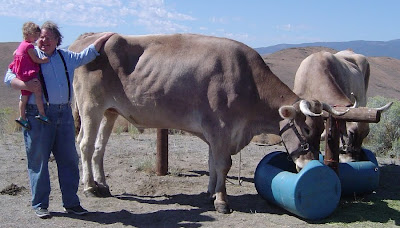
One of the reasons Dan and I headed to Oregon was the desire to see the Oregon Trail Interpretive Center in Baker City. My advice is if you go to this incredible museum you do not do it with 2 and 5year old grandchildren (especially if one of them is terrified of stuffed animals and animatronics..LOL).

Here are some wonderful pictures of this amazing tribute to those who travelled the Oregon Trail. Dan and I will be going back soon to see it again (this time by ourselves) but for now here is some information on it as well as some great pics.

The National Historic Oregon Trail Interpretive Center offers living history demonstrations, interpretive programs, exhibits, multi-media presentations, special events, and more than four miles of interpretive trails.

During eight decades in the 1800s the Oregon Trail served as a natural corridor as the United States moved from the eastern half of the continent toward the west coast. The Oregon Trail ran approximately 2,000 miles west from Missouri toward the Rocky Mountains to the Willamette Valley. A trail to California branched off in southern Idaho. The Mormon Trail paralleled much of the Oregon Trail, connecting Council Bluffs to Salt Lake City.

It began as an unconnected series of trails used by Native Americans. Fur Traders expanded the route to transport pelts to trading posts and rendezvous. In the 1830s missionaries followed the still faint trail along the Platte River and the Snake to establish church connections in the Northwest. A combination of economic and political events in the 1840s converged to start a large scale migration west on what was then known as "The Oregon Road." Joel Walker is credited as the first settler to make the complete trip with a family, in 1840. Large scale migration started in 1843, when a wagon train of over 800 people with 120 wagons and 5,000 cattle made the five month journey. In 1847 Mormons escaping persecution headed toward Salt Lake, and the discovery of gold in California in 1848 sent a wave of fortune seekers west. Military posts, trading posts, shortcuts, and spur roads sprang off the Oregon Trail over the next three decades. The Central Pacific Railroad connected California to the continent in 1869, and the Oregon Shortline finished a railroad from Portland, Oregon to the Union Pacific railroad in Wyoming in 1884. Wagon trains gave way to modern transportation. The trail became a route for eastward cattle drives, but by the twentieth century, the Oregon Trail was considered part of a historic past, and the image of covered wagons and heroic pioneers had become an American icon.
Ezra Meeker, a pioneer of 1852, took steps to preserve and commemorate the Oregon Trail by staging several west-to-east trips over the trail, beginning in 1906. He organized communities to place markers along the trail route. His efforts led to further recognition of the historic significance of this national travel corridor by community, state, and national organizations. In 1978, Congress designated it the Oregon National Historic Trail. Through the years, many remnants of the trail disappeared under construction of towns, highways, and agricultural development, but over 300 miles of ruts still exist. The National Historic Trail is administered by the National Park Service in partnership with the Bureau of Land Management, the Forest Service, state and local governments, citizen organizations, and private individuals who own or manage property crossed by the trail route. Through their efforts of preservation and education, it is still possible to follow the route of the Oregon Trail by auto and hiking, and to visit over 125 historic sites associated with the Oregon Trail.
Exploring the Oregon Trail off of Whidbey Island.
No comments:
Post a Comment